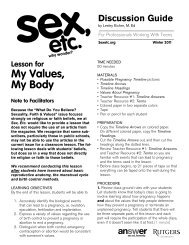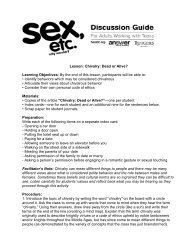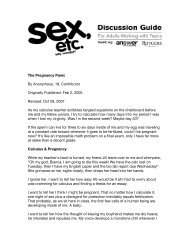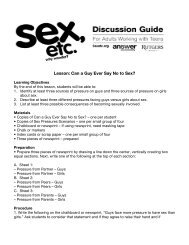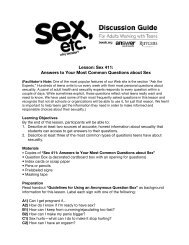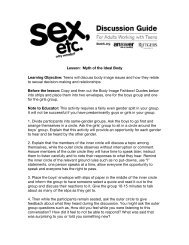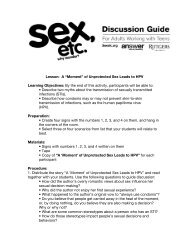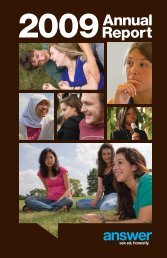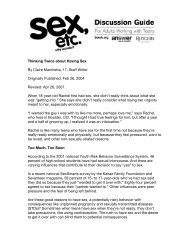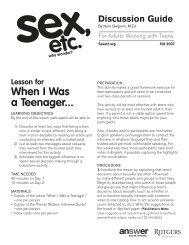Lesson For Is This Normal? - Answer
Lesson For Is This Normal? - Answer
Lesson For Is This Normal? - Answer
You also want an ePaper? Increase the reach of your titles
YUMPU automatically turns print PDFs into web optimized ePapers that Google loves.
<strong>Lesson</strong> for<br />
<strong>Is</strong> <strong>This</strong> <strong>Normal</strong>?<br />
LEARNING OBJECTIVES<br />
By the end of this lesson, participants will be able to<br />
1) List at least four facts about normal anatomy<br />
and healthy reproductive organ function.<br />
2) List at least two facts about unhealthy<br />
reproductive organ function.<br />
3) Describe at least two places a teen could<br />
go to get health care information.<br />
TIME NEEDED<br />
50 minutes<br />
MATERIALS<br />
• Copies of “<strong>Is</strong> <strong>This</strong> <strong>Normal</strong>?”—one per student<br />
• “<strong>Is</strong> <strong>This</strong> <strong>Normal</strong>?: Statements for Facilitators”–<br />
one copy<br />
• 10 index cards with “<strong>Normal</strong>” written on them<br />
• 10 index cards with “See the Doctor” written<br />
on them<br />
• Flipchart paper and marker or chalkboard and<br />
chalk<br />
• Timer with second hand<br />
• Small prizes for winning team—optional<br />
Discussion Guide<br />
By Nora Gelperin, M.Ed.<br />
<strong>For</strong> Professionals Working with Teens<br />
Sexetc.org Spring 2008<br />
PREPARATION<br />
You will need to preselect two students to serve as<br />
judges, preferably one male and one female. These<br />
students should have the maturity to handle this<br />
special role during the activity.<br />
PROCEDURE<br />
1. Explain to students that this lesson will cover<br />
common concerns that teens might have about<br />
their reproductive and sexual body parts and how<br />
they function. Ask students to brainstorm which<br />
body parts are considered sexual or reproductive.<br />
Write their responses on the board or flipchart<br />
paper and make sure the list includes the following:<br />
• Male—penis, scrotum and testicles<br />
• Female—breasts, vulva and vagina<br />
[2 minutes]<br />
2. Next, ask students to brainstorm some possible<br />
concerns that teens might have about these body<br />
parts and how they function. Write their responses<br />
on the board or flipchart paper. (Facilitator’s Note:<br />
Responses might include penis size, breast size, sexual<br />
function, infections, erections, etc.)<br />
[3 minutes]<br />
3. Explain that you will be dividing students into<br />
groups of four to form teams. Each team will be<br />
given two cards, one that says “normal” and another<br />
that says “see the doctor.” Explain that you will read<br />
statements and the group will have 30 seconds to
determine whether it is normal or someone should<br />
see the doctor. When you call time, one person from<br />
each group should hold up the card that shows<br />
their team’s guess. Ask if there are any questions<br />
about the directions. [2 minutes]<br />
4. Next, explain that there will be two student<br />
judges who will be given copies of the Sex, Etc.<br />
article “<strong>Is</strong> <strong>This</strong> <strong>Normal</strong>?.” All of the questions and<br />
answers are contained in this article, and the student<br />
judges will have final say on whether a team gets<br />
the point for a correct answer or not. Your role will<br />
be scorekeeper. Ask the two students you have<br />
preselected to come to the front of the room and<br />
give them each a copy of the article “<strong>Is</strong> <strong>This</strong> <strong>Normal</strong>?”<br />
to briefly review. [3 minutes]<br />
5. Divide students into groups of four using the<br />
dividing technique attached to this lesson or one of<br />
your choosing. Give students two minutes to create<br />
a team name and write each of these on the<br />
flipchart paper or chalkboard where you will keep<br />
score. [2 minutes]<br />
6. Read the first statement and start keeping time,<br />
reminding groups that they will need to raise the<br />
card with their group’s answer when the time is up.<br />
When time is up, turn to a student judge, ask for<br />
the correct answer and award a point to the groups<br />
who answered correctly. Add in any additional<br />
information about each statement as time permits<br />
and student interest warrants. [3 minutes]<br />
7. Continue reading through each statement,<br />
alternating student judges and awarding points until<br />
all ten statements have been read. [20 minutes]<br />
8. Explain that the final question will be a bonus<br />
question worth five points. Ask each group to write<br />
five places where a teen could go to get more<br />
information about reproductive and sexual health in<br />
their community. Explain that no partial credit will<br />
be awarded. Allow groups one minute to complete.<br />
[5 minutes]<br />
9. Ask each group to list their five resources and<br />
ask the student judges to write all responses on a<br />
flipchart paper or chalkboard. Award points to each<br />
group that has five valid resources and award<br />
prizes to group(s) with the highest scores.<br />
[10 minutes]<br />
Special thanks to Teri Tomatich, M.Ed., for her<br />
review of this lesson plan.
<strong>Is</strong> <strong>This</strong> <strong>Normal</strong>?<br />
Statements for Facilitators<br />
1) A guy’s penis curves a bit to the right or left.<br />
2) One breast is a little bit bigger than the other.<br />
3) One testicle hangs lower than the other in the scrotum.<br />
4) A girl is born without a hymen (the thin piece of tissue<br />
that partially covers the opening to the vagina).<br />
5) A guy feels a slight burning when he urinates (pees).<br />
6) A girl has a white or clear discharge every day.<br />
7) Every time a girl has sexual intercourse, it hurts.<br />
8) A guy’s penis is an inch smaller than his younger<br />
brother’s penis.<br />
9) A girl feels like she has to urinate (pee) all the time.<br />
10) One guy has a foreskin and his cousin does not.<br />
NORMAL<br />
NORMAL<br />
NORMAL<br />
NORMAL<br />
SEE THE DOCTOR<br />
NORMAL<br />
SEE THE DOCTOR<br />
NORMAL<br />
SEE THE DOCTOR<br />
NORMAL
Dividing Technique to<br />
Create Groups of Four<br />
Copy and cut these into strips and shuffle. Distribute one to each student and explain that they are to find<br />
the three other ingredients that will complete their dish. There are enough strips for 28 students to create<br />
seven groups of four.<br />
HAMBURGER<br />
KETCHUP AND MUSTARD<br />
TACO SHELLS<br />
SALSA AND SOUR CREAM<br />
SUSHI<br />
SOY SAUCE<br />
ICE CREAM<br />
WHIPPED CREAM<br />
SPAGHETTI SAUCE<br />
PARMESAN CHEESE<br />
SCRAMBLED EGGS<br />
HASH BROWNS<br />
PIZZA CRUST<br />
MOZZARELLA CHEESE<br />
HAMBURGER BUN<br />
PICKLES, LETTUCE AND TOMATOES<br />
GROUND BEEF SEASONED WITH<br />
TACO SAUCE<br />
SHREDDED CHEESE, TOMATOES<br />
AND LETTUCE<br />
WASABI<br />
CHOPSTICKS<br />
HOT FUDGE<br />
CHERRY AND SPRINKLES<br />
SPAGHETTI<br />
MEATBALLS<br />
TOAST<br />
BACON OR SAUSAGE<br />
PIZZA SAUCE<br />
PEPPERONI OR SAUSAGE



